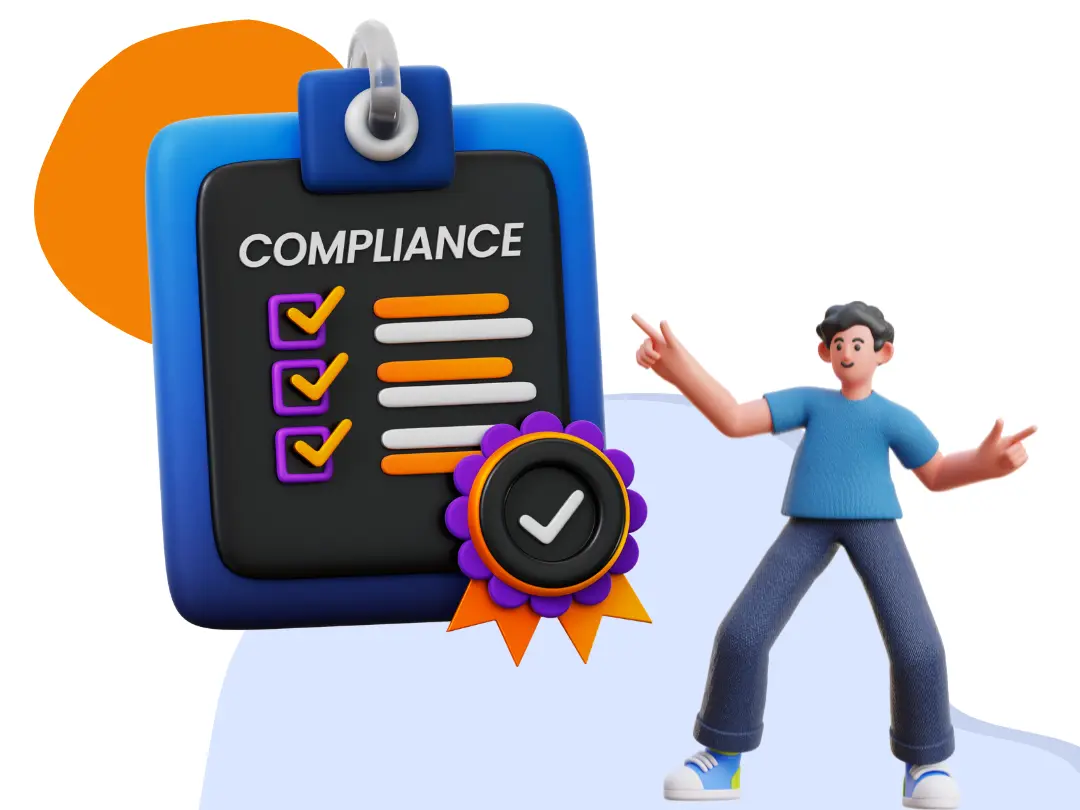IT Compliance
Why is IT Compliance Required and What are the types of compliances?
Share:

Get to know about:
What is the importance of IT Compliance?
IT compliance means following guidelines and regulations to safeguard digital information within your business. Think of it as ensuring that your digital valuables are under lock and key, preventing any unauthorized access or misuse. In the digital landscape, these regulations are crucial for protecting sensitive data. They encompass various aspects, including legal requirements, industry standards, and internal policies tailored to your business.
These rules work together like a well-oiled machine, ensuring that data remains secure and trustworthy. It’s a collaborative effort between regulations, standards, and policies to maintain safety and reliability. So, when you follow IT compliance, you’re not only protecting your own data but also earning the trust of your customers and stakeholders.
Non-compliance can leave a huge dent in your organization’s balance sheet.
According to benchmark study conducted by Ponemon Institute in 2017, the average cost for organizations that experience non-compliance problems was $14.82 million.
6 Types of IT Compliance
1. GDPR
The General Data Protection Regulation (GDPR) comprises a set of IT regulations enforced by the European Union (EU). Designed to safeguard the digital information of European citizens, GDPR compliance standards are obligatory for any entity collecting data related to EU citizens. For instance, companies or individual sellers from the United States catering to EU citizens must adhere to GDPR if they monitor their behavior. A notable regulation within GDPR involves obtaining explicit consent from users before collecting their data. This ensures transparency and grants users the option to decline, thus preserving their privacy.
2. PCI DSS
The Payment Card Industry Data Security Standard – PCI DSS governs the security of financial card data, encompassing debit and credit card numbers.
Applicable to businesses conducting online transactions involving the storage, transmission, and management of user financial information, adherence to PCI DSS fosters transparency and trust with clients. Businesses often implement robust systems to host and protect customer financial data to meet these standards.
3. SOX
The Sarbanes-Oxley Act (SOX) stands as a financial compliance standard mandating complete and transparent disclosure of a company’s financial information, especially for publicly traded companies or those launching initial public offerings. By ensuring accurate financial reporting, SOX aims to empower stakeholders to make informed investment decisions, while also deterring fraud and streamlining business workflows.
4. HIPAA
The Health Insurance Portability and Accountability Act (HIPAA) ensures the security of patient health records within the healthcare industry.
Applicable to entities handling, accessing, or transferring medical records, HIPAA mandates stringent privacy regulations, robust data security measures, and immediate notification systems in case of security breaches.
5. GLBA
The Gramm-Leach-Bliley Act (GLBA) applies to financial institutions offering investment, financial advice, insurance, or loans.
Institutions covered by GLBA must disclose data protection policies and provide customers with the option to opt in or out of information-sharing practices. The act encompasses rules regarding financial privacy, safeguarding client data, and preventing pretexting.
6. FISMA
The Federal Information Security Management Act (FISMA) targets federal agencies, requiring the implementation of information security plans to protect sensitive information.
It necessitates the development of data protection strategies, promotes various security software and systems, and mandates third-party vendor verification. Compliance with FISMA varies based on the nature of federal agencies, with stringent requirements for those focused on national security. Businesses working with government agencies must also be mindful of FISMA regulations.
Challenges associated with IT compliance
IT compliance is essential for ensuring that organizations adhere to relevant laws, regulations, and standards governing data security, privacy, and governance. Here are five top challenges faced in IT compliance:
1. Complex Regulations
Navigating a complex regulatory landscape can present significant challenges for organizations. Not to forget that Compliance requirements, spanning across various jurisdictions and industries, require meticulous attention to detail. You must continously monitor and adapt to evolving regulations such as GDPR, HIPAA, PCI-DSS, SOX, and others requires continuous monitoring and adaptation. If an organisation wants to ensure adherence to these regulations then it should be able to interpret legal jargon, understand industry-specific nuances, and implement tailored compliance measures. In case you are unable to comply then you may face severe consequences, including fines, legal actions, reputational damage, and loss of customer trust. Also note that Regulations keep evolving and new ones emerge so organizations must remain proactive and agile to handle risk.
2. Not having an automated process
The absence of an automated process can lead to compliance challenges for your organization. Manual handling of compliance tasks introduces inefficiencies, increases the likelihood of errors, and consumes valuable resources. Without automation your organization will struggle to streamline repetitive compliance activities such as data collection, analysis, and reporting. The manual approach will slow down processes and it also leaves room for gaps. Moreover, without automated monitoring and alert systems, your organization may fail to promptly identify and address compliance issues, leaving it vulnerable to regulatory violations. Implementing automated processes can enhance efficiency, accuracy, and agility in meeting compliance requirements. It will help you to manage risks proactively and save your time and effort aswell.
3. Having too many applications
If your organisation is having a diverse array of applications then there are high chances of complexities in ensuring each one adheres to relevant compliance standards. With multiple applications, organization will face challenges in maintaining consistency across compliance measures, as each application will have its own set of requirements and updates. Additionally, the sheer volume of applications increases the attack surface, heightening security risks and regulatory concerns.
Furthermore, managing licenses, updates, and patches for numerous applications demands significant resources and can strain IT teams. Inadequate oversight of these applications may lead to compliance breaches, such as unauthorized access, data breaches, or non-compliant software usage.
Can Codeless ONE help in managing IT compliance?
Codeless ONE can significantly support IT compliance efforts through automation, streamlining processes, and reducing the potential for human error.
Firstly, it empowers users to create custom solutions tailored to their compliance needs without any coding. With automation capabilities, Codeless ONE can automate routine compliance tasks such as data validation, audit trail generation, and regulatory reporting.
By configuring workflows and triggers within your application, you can ensure that compliance requirements are consistently met without manual intervention, thereby minimizing the risk of oversight or oversight errors.
Furthermore, Codeless ONE facilitates rapid adaptation to evolving compliance standards. As regulations change or new requirements emerge, organizations can quickly modify or create new compliance processes using intuitive interface, eliminating the need for lengthy development cycles or reliance on scarce technical resources.
This agility enables IT teams to stay ahead of compliance challenges and ensure that their systems and processes remain up-to-date and aligned with regulatory mandates.
Overall, by harnessing the power of automation and simplicity offered by Codeless ONE, organizations can enhance their IT compliance posture while reducing operational overhead and mitigating compliance-related risks.

Take advantage of no-code to get ahead of your competitors.
No-Code development platform for all your unique projects.









